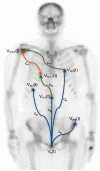Dosimetric Analysis of the Short-Ranged Particle Emitter 161Tb for Radionuclide Therapy of Metastatic Prostate Cancer
- PMID: 33921956
- PMCID: PMC8122331
- DOI: 10.3390/cancers13092011
Dosimetric Analysis of the Short-Ranged Particle Emitter 161Tb for Radionuclide Therapy of Metastatic Prostate Cancer
Abstract
The aim of this study was to analyze the required absorbed doses to detectable metastases (Dreq) when using radionuclides with prostate specific membrane antigen (PSMA)-targeting radioligands to achieve a high probability for metastatic control. The Monte Carlo based analysis was performed for the clinically-used radionuclides yttrium-90, iodine-131, lutetium-177, and actinium-225, and the newly-proposed low-energy electron emitter terbium-161. It was demonstrated that metastatic formation rate highly influenced the metastatic distribution. Lower values generated few large detectable metastases, as in the case with oligo metastases, while high values generated a distribution of multiple small detectable metastases, as observed in patients with diffused visualized metastases. With equal number of detectable metastases, the total metastatic volume burden was 4-6 times higher in the oligo metastatic scenario compared to the diffusely visualized scenario. The Dreq was around 30% higher for the situations with 20 detectable metastases compared to one detectable metastasis. The Dreq for iodine-131 and yttrium-90 was high (920-3300 Gy). The Dreq for lutetium-177 was between 560 and 780 Gy and considerably lower Dreq were obtained for actinium-225 and terbium-161, with 240-330 Gy and 210-280 Gy, respectively. In conclusion, the simulations demonstrated that terbium-161 has the potential for being a more effective targeted radionuclide therapy for metastases using PSMA ligands.
Keywords: 161Tb; PSMA; dosimetry; prostate cancer.
Conflict of interest statement
The authors declare no conflict of interest.
Figures




References
-
- Bander N.H., Trabulsi E.J., Kostakoglu L., Yao D., Vallabhajosula S., Smith-Jones P., Joyce M.A., Milowsky M., Nanus D.M., Goldsmith S.J. Targeting metastatic prostate cancer with radiolabeled monoclonal antibody J591 to the extracellular domain of prostate specific membrane antigen. J. Urol. 2003;170:1717–1721. doi: 10.1097/01.ju.0000091655.77601.0c. - DOI - PubMed
-
- Von Eyben F.E., Roviello G., Kiljunen T., Uprimny C., Virgolini I., Kairemo K., Joensuu T. Third-line treatment and 177Lu-PSMA radioligand therapy of metastatic castration-resistant prostate cancer: A systematic review. Eur. J. Nucl. Med. Mol. Imaging. 2018;45:496–508. doi: 10.1007/s00259-017-3895-x. - DOI - PMC - PubMed
-
- Baum R.P., Kulkarni H.R., Schuchardt C., Singh A., Wirtz M., Wiessalla S., Schottelius M., Müller D., Klette I., Wester H.J. 177Lu-Labeled Prostate-Specific Membrane Antigen Radioligand Therapy of Metastatic Castration-Resistant Prostate Cancer: Safety and Efficacy. J. Nucl. Med. 2016;57:1006–1013. doi: 10.2967/jnumed.115.168443. - DOI - PubMed
-
- Okamoto S., Thieme A., Allmann J., D’Alessandria C., Maurer T., Retz M., Tauber R., Heck M.M., Wester H.J., Tamaki N., et al. Radiation Dosimetry for 177Lu-PSMA I&T in Metastatic Castration-Resistant Prostate Cancer: Absorbed Dose in Normal Organs and Tumor Lesions. J. Nucl. Med. 2017;58:445–450. doi: 10.2967/jnumed.116.178483. - DOI - PubMed
-
- Zechmann C.M., Afshar-Oromieh A., Armor T., Stubbs J.B., Mier W., Hadaschik B., Joyal J., Kopka K., Debus J., Babich J.W., et al. Radiation dosimetry and first therapy results with a 124I/ 131I-labeled small molecule (MIP-1095) targeting PSMA for prostate cancer therapy. Eur. J. Nucl. Med. Mol. Imaging. 2014;41:1280–1292. doi: 10.1007/s00259-014-2713-y. - DOI - PMC - PubMed
LinkOut - more resources
Full Text Sources
Other Literature Sources
Miscellaneous

